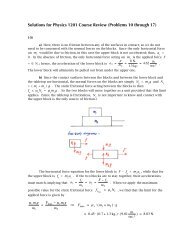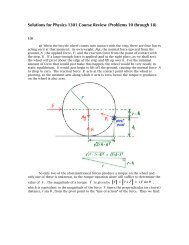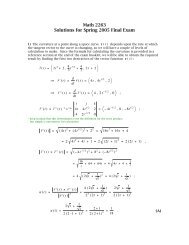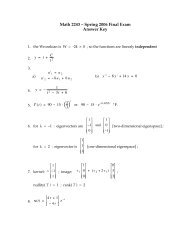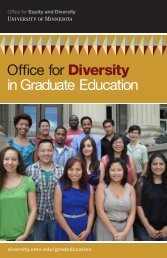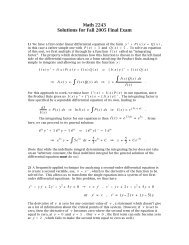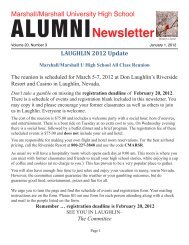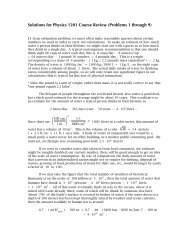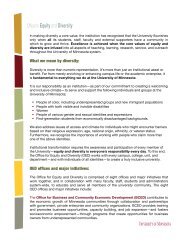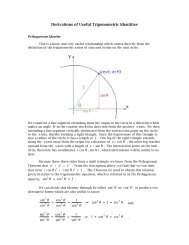Best Practices In Recruiting And Retaining Under-represented U.S. ...
Best Practices In Recruiting And Retaining Under-represented U.S. ...
Best Practices In Recruiting And Retaining Under-represented U.S. ...
Create successful ePaper yourself
Turn your PDF publications into a flip-book with our unique Google optimized e-Paper software.
Office for Equity and Diversity<br />
<strong>Best</strong> <strong>Practices</strong> <strong>In</strong><br />
<strong>Recruiting</strong> and <strong>Retaining</strong><br />
<strong>Under</strong>-Represented U.S. Minority Faculty<br />
at the University of Minnesota<br />
A handbook<br />
for institutional leaders and faculty search committees<br />
1
TABLE OF CONTENTS<br />
4<br />
<strong>In</strong>troduction: The Case For Faculty Diversity<br />
5<br />
Data On Significant Demographic Trends<br />
8<br />
<strong>Best</strong> <strong>Practices</strong> Leading To Results <strong>In</strong> The Search Process<br />
10<br />
Frequently Asked Questions<br />
The hiring process continues to be one of the most<br />
conservativeprocesses at institutions of higher learning.<br />
12<br />
12<br />
15<br />
<strong>Retaining</strong> Our Diverse Faculty<br />
<strong>Best</strong> <strong>Practices</strong> For <strong>Retaining</strong> Diverse Faculty<br />
References<br />
—Michael Tapia, Professor of Computational and Applied Mathematics at Rice University’s George R. Brown School of Engineering 2<br />
16<br />
Appendices<br />
A. Terminology<br />
B. <strong>Recruiting</strong> Resources For Women <strong>And</strong> People Of Color<br />
C. Programs <strong>And</strong> Resources To Support <strong>And</strong> Retain Diverse Faculty<br />
Efforts to diversify faculty continue to be amongst the<br />
least successful elements of university commitments to diversity.<br />
—Dr. Caroline Tuner, noted Diversity Scholar. 1<br />
Cover Photos: (left to right) Walt Jacobs, Rose Brewer, Hakim Abderrezak, Dominic Taylor, Keletso Atkins,<br />
Jimmy Patino, Richa Nagar, and Clint Carroll.<br />
<strong>In</strong>side Photos: Page 9: Teresa Swartz. Page 12: Erika Lee. Page 14 Heidi Barajas. Page 17: Selwin Vickers and<br />
Jasjit Ahluwalia. Page 19: Yuichiro Onishi<br />
This document was compiled by Catherine Squires and Louis Mendoza of the <strong>In</strong>stitute for Diversity, Equity and<br />
Advocacy (IDEA), a unit of the Office for Equity and Diversity (OED) at the University of Minnesota. Additional<br />
copies may be downloaded on the IDEA website at z.umn.edu/IDEA. The FAQs are available to be downloaded as<br />
a separate document for use by faculty search committees. This document offers insight into best practices culled<br />
from documented efforts by colleagues from around the country. We have borrowed liberally from the sources in<br />
the reference section at the end of the document. As is asserted in the pages that follow, efforts to recruit and retain<br />
a racially and ethnically diverse faculty are crucial for institutional well-being. A deliberate effort is needed to depart<br />
from past practices and attitudes that often rest on faulty assumptions and detrimentally impact campus climate<br />
and impede the University’s ability to produce citizens and scholars engaged in an increasingly complex world.<br />
Please contact us at oedidea@umn.edu if you have any suggestions for improving this handbook.<br />
2 3
INTRODUCTION: THE CASE FOR FACULTY DIVERSITY<br />
DATA ON SIGNIFICANT DEMOGRAPHIC TRENDS<br />
Diversity is a fundamental core value of the University of Minnesota and crucial to<br />
the University’s land-grant mission of advancing excellence in teaching, research,<br />
service, and community engagement. The University of Minnesota’s commitment<br />
to enhancing the diversity of its faculty is premised on the idea that research and<br />
teaching are enriched by a variety of perspectives and multiple ways of knowing<br />
and being in the world. When diversity of thought and experience are core values<br />
of teaching and research: 1) Academic excellence is advanced because students<br />
are better prepared to live and work in an increasingly global, pluralistic, and<br />
multicultural society; 2) Communities are strengthened because all members are<br />
judged by their character and contributions; 3) Teamwork, respect, innovation and<br />
collaboration are fostered; 4) Our economic well-being is strengthened as we utilize<br />
the skills of individuals from different ethnic backgrounds, cultures and communities,<br />
and; 5) The University will be seen as a more attractive place of learning and<br />
teaching for students and faculty of color. Diversity is a key ingredient of a quality<br />
education, scholarly discourse, and reflection. Faculty, staff, and students alike<br />
benefit from learning to function within a setting that allows or demands that one<br />
adapt to the complex social structures of having to learn from, teach or work with<br />
those who are not like oneself.<br />
“ Since they were an all-white department and<br />
had never had a minority colleague, I wish they<br />
had gone through some training on how to deal<br />
with people different from themselves.” *<br />
While Minnesota is still not nearly as racially diverse as the nation, we are becoming more diverse. About 15 percent of our state’s<br />
residents are now persons of color, compared to only about 1 percent in 1960. Between 2000 and 2009, the state’s population of<br />
color grew by 38 percent, compared to only 3 percent among whites.<br />
According to the Minnesota State<br />
Demographic Center:<br />
• The percent of Minnesota’s population that is nonwhite or<br />
Latino is projected to grow from 14 percent in 2005 to 25<br />
percent in 2035.<br />
• The numbers of Latino, black, and Asian Minnesotans are<br />
projected to more than double over the next 30 years.<br />
• All regions of the state will become more racially and<br />
ethnically diverse than they are now.<br />
• Because the white population is older on average, experiences<br />
little or no in-migration, and has a slightly lower fertility<br />
rate, it is not projected to show much growth. The total white<br />
alone population is projected to increase about 4 percent<br />
between 2005 and 2015 and show little growth thereafter.<br />
Overall, the white population is projected to grow nine percent<br />
over 30 years, compared to 112 percent for the total<br />
minority population. The proportion of the population that is<br />
white alone, not Latino is projected to fall from 86 percent in<br />
2005 to 75 percent in 2035.<br />
• The Latino population is projected to rise rapidly, growing<br />
from an estimated 196,300 in 2005 to 324,400 in 2015 and<br />
551,600 in 2035. All regions of the state are expected to see<br />
increases. About two-thirds of the total Latino population is<br />
projected to live in the seven-county Twin Cities area<br />
by 2035.<br />
• Large gains are also projected for the black or African<br />
American alone population. This group is projected to grow<br />
from 218,400 in 2005 to 454,400 in 2035. The Twin Cities is<br />
projected to account for 83 percent of the state total black<br />
population in 2035.<br />
Additionally, the University of Minnesota and the Twin Cities are<br />
nationally known for having a large and vibrant GLBT community,<br />
with many resources and cultural institutions for the GLBT<br />
community. Minneapolis was recently named the “Gayest City<br />
in America” by The Advocate, the national gay news magazine<br />
based in Los Angeles. The University’s Gay, Lesbian, Bisexual,<br />
Transgender, Ally Programs Office (GLBTA) is one of the largest<br />
in the country and sponsors programs that build GLBTA<br />
leaders with expertise on the intersectionality of identities. The<br />
increased visibility, activism and involvement of out GLBT students<br />
and faculty are part of what makes the University excel<br />
in diversity. Likewise, the Disability Services Office has received<br />
national accolades for the comprehensive nature of support<br />
services offered to students, staff and faculty in teaching and<br />
learning, as well as the elimination of institutional barriers. The<br />
Office for Equity and Diversity (OED) seeks to support and<br />
nurture the increasingly complex diversity of our world, and<br />
remains vigilant in its efforts to support the University of<br />
Minnesota in further diversifying its faculty.<br />
<strong>Recruiting</strong>, promoting, and retaining a diverse faculty are<br />
crucial for the university to achieve its mission of excellence<br />
in education. The Office for Equity and Diversity’s units, the<br />
Women’s Center (WmC), the Gay, Lesbian, Bisexual, Transgender<br />
and Ally Programs Office, Disability Services (DS), and<br />
Equal Opportunity and Affirmative Action (EOAA) support our<br />
diverse faculty by developing and maintaining a supportive<br />
climate through trainings, programs and support services that<br />
promote an inclusive climate. While the University of Minnesota<br />
has provided faculty, staff and students with an education and<br />
working environment that values excellence and inclusivity, we<br />
have struggled to provide a faculty workforce—and an accompanying<br />
environment—that is representative of society’s ethnic<br />
diversity. <strong>In</strong> spite of the University’s sustained commitment<br />
to diversity, some ethnic minority groups remain under<strong>represented</strong><br />
among our faculty and staff. Among the University’s 22<br />
academic colleges, many have fewer U.S.-born faculty of color<br />
than we would expect, given the availability of minority Ph.D.s<br />
in specific disciplines throughout the nation. With increasing<br />
ethnic diversity in Minnesota, the number of students of color<br />
at the University will continue to grow and demographic data<br />
indicates that this trend will continue well into the future.<br />
1<br />
Turner, C. S. V. (2002). Diversifying the faculty: A guidebook for search committees. Washington, DC: Association of American Colleges and Universities.<br />
2<br />
http://www.prism-magazine.org/oct02/facingproblem.cfm<br />
* These comments come from a recent survey of diverse faculty currently employed at the University of Minnesota. Average length of employment of<br />
3<br />
respondents is 3 years.<br />
http://www.mncompass.org/demographics/index.php<br />
4<br />
http://www.demography.state.mn.us/documents/MinnesotaPopulationProjectionsbyRaceandHispanicOrigin2005to2035.pdf<br />
4 5
comparison of uofm twin cities<br />
undergraduate student enrollment<br />
uofm twin cities undergraduate<br />
student of color enrollment<br />
comparison of uofm twin cities<br />
Tenured and tenure-track facility<br />
uofm twin cities Tenured and<br />
tenure-track facility<br />
Fall 2001 and Fall 2010<br />
Fall 2001 and Fall 2010<br />
Fall 2004 and Fall 2010<br />
Fall 2004 and Fall 2010<br />
90%<br />
80%<br />
70%<br />
80%<br />
74%<br />
6,000<br />
5,000<br />
90%<br />
80%<br />
70%<br />
84%<br />
82%<br />
500<br />
400<br />
60%<br />
4,000<br />
60%<br />
300<br />
50%<br />
40%<br />
3,000<br />
50%<br />
40%<br />
200<br />
30%<br />
20%<br />
10%<br />
0%<br />
18%<br />
15%<br />
10%<br />
8%<br />
4% 1 % 2% 2% 3% 5%<br />
1 % 2%<br />
FALL 2001 FALL 2010<br />
6%<br />
2%<br />
2,000<br />
1,000<br />
2001 2002 2003 2004 2005 2006 2007 2008 2009 2010<br />
30%<br />
20%<br />
10%<br />
10%<br />
15%<br />
12%<br />
0%<br />
2%<br />
1% 5%<br />
2% 2% 2%<br />
2004 2010<br />
18%<br />
100<br />
2004 2005 2006 2007 2008 2009 2010<br />
Total Faculty of Color<br />
African American<br />
African American<br />
Total Students of Color<br />
Total Students of Color<br />
Chicano/Latino<br />
African American<br />
Chicano/Latino<br />
Asian American<br />
Chicano/Latino<br />
American <strong>In</strong>dian<br />
White<br />
Asian American<br />
American <strong>In</strong>dian<br />
American <strong>In</strong>dian<br />
Total Faculty of Color<br />
Asian American<br />
<strong>In</strong>ternational<br />
African American<br />
Asian American<br />
Non-Minority Faculty<br />
Chicano/Latino<br />
Not Reported<br />
According to the ACE Status Report, between 1980 and 2000, Latino and Asian college enrollment tripled while African American<br />
college enrollment increased by 56%, and the overall number of people of color attending college has more than doubled in the<br />
past three decades. By 2015, it is estimated that 80% of new college entrants will be people of color and the overall number of<br />
students of color enrolled in U.S. colleges will increase from 29.4% to 37.2%. Since 1980, the number of women of color earning<br />
college degrees increased by 384.8 %. Today, women of color represent about 50% of the total minority enrollment population.<br />
The 2002-03 Ace Status Report also reveals that between 1980 and 2000, faculty of color increased to 13.8% nationally as seen<br />
in the chart below.<br />
African American 5%<br />
Hispanic or Latino 2.7%<br />
Asian American 5.7%<br />
Native American 0.4%<br />
At the University of Minnesota, the underrepresentation<br />
of African American, American <strong>In</strong>dian, and Chicano/Latino<br />
faculty persists.<br />
At first glance, the University of Minnesota’s overall numbers of 18% faculty of color looks strong. But a closer examination of the<br />
data reveals that although there is a rapid increase in the population of students of color attending higher education institutions,<br />
there is no trend indicating a parallel significant rate of increase in U.S.-born faculty of color.<br />
uofm twin cities Tenured and<br />
tenure-track facility of Color<br />
Origin of birth<br />
Fall 2010<br />
52%<br />
4%<br />
Native-Born Faculty of Color<br />
44%<br />
According to a recent survey by the Bernard Hodes Group and<br />
the Ph.D. Project: 96% of undergraduate and graduate students<br />
of color indicate that professors of color have positively<br />
impacted their education and 83 % of White undergraduate<br />
and graduate students indicate that professors of color have<br />
positively impacted their education. Thus, it becomes even<br />
more critical to have faculty and staff from under<strong>represented</strong><br />
communities of color in the U.S. who can support these students,<br />
offer a diverse curriculum that engages the complexity<br />
of the world we live in, and serve as role models and mentors.<br />
We must identify and undertake efforts that will help ensure a<br />
climate that is inclusive, embracing a wide array of differences<br />
that will be enhance excellence and inclusion at the university.<br />
Efforts of recruitment and retention are necessarily interdependent<br />
and work together toward the goal of diversifying faculty<br />
and staff. As the University of Minnesota strives to become<br />
one of the nation’s premier universities, it is critical that we reflect<br />
the nation’s growing diversity of faculty, staff and students.<br />
Foreign-Born Faculty of Color<br />
Not Reported<br />
If we are to achieve our goal of diversifying the faculty, we must<br />
go beyond rhetoric and good intention and take actions to<br />
develop practices and attitudes that depart from past patterns<br />
that have produced the under-representation of faculty of color<br />
at the U of M.<br />
6 7
RECRUITING DIVERSE FACULTY<br />
<strong>In</strong> order to increase the racial and ethnic diversity of our faculty,<br />
departments and colleges must align their values with strategies<br />
for effective recruiting. Ideally, colleges and departments<br />
will have diversity plans or diversity committees already in<br />
place, providing guideposts for curricular and research needs<br />
and how diverse faculty fit into those needs. However, even<br />
units that do not have formal diversity plans can find more<br />
ways to achieve more diversity in hiring.<br />
“ Though the number of diverse faculty is small<br />
in this department, we just hired a man of color<br />
for next year. This was an opportunity hire,<br />
similar to the scenario that brought me here,<br />
so I think there is a core group of people in this<br />
department who really want to see diversity<br />
flourish here and in the larger College. I feel<br />
fortunate to be a part of this community.”<br />
LEGAL ISSUES TO CONSIDER WHILE PURSUING<br />
FACULTY DIVERSIFICATION<br />
It is, of course, discriminatory to use race or gender as the sole<br />
criteria in developing position descriptions, but recruiting diverse<br />
candidates is never simply about one criterion. It is legal,<br />
however, to recruit under<strong>represented</strong> minorities and women<br />
to the faculty. Executive Order 11246 requires universities and<br />
other federal contractors to make good faith affirmative action<br />
efforts to hire and retain women and people of color. It is legal<br />
to place emphasis on criteria such as “academic experience<br />
with diverse students,” and to use other recommended<br />
language in the previous section. <strong>And</strong>, certain positions, such<br />
as bridge postdoctoral fellowships, may require you to specify<br />
that applicants be members of under<strong>represented</strong> minority groups.<br />
• Use the assistance of the Office for Equal Opportunity and<br />
Affirmative Action (EOAA) to create consistent interview and<br />
reference checking policies and practices.<br />
• <strong>Under</strong>stand how to properly conduct a search within<br />
legal boundaries.<br />
BEST PRACTICES LEADING TO RESULTS IN<br />
THE SEARCH PROCESS<br />
CREATE A DIVERSE SEARCH COMMITTEE<br />
A diverse search committee makes it more likely that you will<br />
end up with a diverse pool of candidates. Deans and department<br />
chairs should actively monitor the composition of search<br />
committees to ensure they include people of different backgrounds,<br />
perspectives, and expertise. Even within units where<br />
there are a few women and minority faculty (or none), committees<br />
can increase the chances of diversifying the pool by<br />
following these suggestions.<br />
• Appoint members with demonstrated commitments<br />
to diversity.<br />
• Ask one member of the committee to serve as a diversity<br />
advocate, if appropriate. This member is responsible for<br />
monitoring the inclusiveness of the pool and the procedures<br />
of the search process.<br />
• Consider adding someone from outside the department<br />
with relevant expertise who would add diversity to the<br />
committee if there are too few women and/or people of<br />
color in the department.<br />
CRAFT A POSITION DESCRIPTION THAT SIGNALS<br />
YOU WANT AND VALUE DIVERSITY OF THOUGHT<br />
AND EXPERIENCE<br />
At the outset, committees should ensure that the position<br />
description is aligned with the unit’s commitment to diversity.<br />
Rather than recycle position descriptions from previous<br />
searches, committees should start fresh to avoid descriptions<br />
that may unintentionally screen out diverse candidates. Diverse<br />
candidates may not have resumes with the same pattern of<br />
experiences as majority candidates. <strong>In</strong>sert language that encourages<br />
qualified people with a different range of experiences<br />
to apply when possible. The description should specifically indicate<br />
that the university is committed to EO/AA, diversity, and<br />
encourages individuals from under<strong>represented</strong> groups to apply.<br />
• Descriptions should include broad commitment to scholarship,<br />
experience, and disciplinary background.<br />
• Years of experience should be “preferred” or “flexible”<br />
if possible.<br />
• <strong>In</strong>clude criteria such as “experience working with diverse<br />
students,” “working in multicultural environments,” or “interest<br />
in developing curricula related to diverse populations”<br />
“experience working with students with different learning<br />
styles: “experience working with students who receive<br />
reasonable accommodations.”<br />
• Be clear about which qualifications are “preferred” and which<br />
are “required.”<br />
USE MULTIPLE, SIMULTANEOUS STRATEGIES<br />
TO RECRUIT DIVERSE FACULTY<br />
Once the position description is ready, it must reach a diverse<br />
set of applicants. If the department or the field is not yet<br />
diverse, then multiple approaches to finding candidates must<br />
be used. Committees should:<br />
“ Diverse members of faculty beyond the search<br />
committee interacted with me when I was on<br />
campus for a job talk. Consequently, they were<br />
able to present the presence of a potentially<br />
enabling intellectual community.”<br />
• Post the advertisement with diverse networks designed to<br />
attract diverse candidates. Many fields have associations<br />
for women and people of color; others have scholarship<br />
and grant programs that may yield promising candidates.<br />
Sending job ads to these organizations and programs is<br />
important to signal that the department is truly interested in<br />
creating a diverse pool.<br />
• Send the ad to senior faculty who are members of under<strong>represented</strong><br />
groups, and/or who have commitments to<br />
diversity in the field. They may have mentored PhDs or junior<br />
faculty who will be good candidates for the job. Consult relevant<br />
publication lists and databases and leverage personal<br />
contacts with colleagues at other institutions to expand the<br />
candidate pool.<br />
• <strong>In</strong> certain cases, having faculty or community members<br />
outside of the department who are known advocates for<br />
diversity serve on the committee may help yield a better<br />
pool, add insight to the applicant review process, and/or aid<br />
in the recruitment effort once candidates visit campus.<br />
• Ask faculty within more racially and ethnically diverse departments<br />
how they have succeeded in contacting diverse<br />
candidates, and borrow strategies that fit your department.<br />
• Approach faculty whose work your department admires,<br />
even if he/she is not known to be “on the market” to gauge<br />
their interest. Even if you assume they are un-moveable due<br />
to family or other obligations, ask anyway. Assumptions<br />
about availability should be verified through direct inquiry,<br />
because the University has resources designed to aid in recruiting<br />
such faculty members. Contact the Office for Equity<br />
and Diversity or relevant Deans for more information about<br />
available recruiting resources.<br />
• If the job posting is on the department web page, create<br />
hyperlinks to community, cultural, and University resources<br />
so interested applicants can explore possible connections<br />
in the community and on campus.<br />
• Provide mentoring to promising undergraduate and graduate<br />
students in your program to increase the potential<br />
applicant pool nationwide in areas where women and<br />
people of color are under<strong>represented</strong>.<br />
• For a list of publications and organization that can increase<br />
your outreach to diverse field of applicants, use the Office of<br />
Equal Opportunity and Affirmative Action’s Diversity Recruitment<br />
Source Database online at http://eoaa.software.umn.<br />
edu/. Also, UCLA maintains a list organized by discipline<br />
at http://www.faculty.diversity.ucla.edu/search/resources/<br />
advertising.htm#soc.<br />
CONSIDER THE COMPOSITION OF THE CANDIDATE POOL<br />
Committee members should discuss and clarify their selection<br />
criteria so that all candidates are being evaluated holistically.<br />
When making a “short list” of candidates, committees should<br />
consider creating a longer list to include more diverse applicants.<br />
After expanding the list, phone interviews can allow<br />
qualified candidates to demonstrate previously overlooked<br />
strengths. If the short list is not sufficiently diverse, the committee<br />
may seriously consider extending the search and revisiting<br />
its advertising strategies to engage more diverse applicants.<br />
THE CAMPUS VISIT<br />
The visit to the campus is important because candidates are<br />
evaluating the department just as the department evaluates<br />
them. During the visit, it is crucial to show interest in candidates’<br />
research and provide them with ample information<br />
about the department’s culture and procedures. Transparency<br />
will allow a candidate to make an informed decision regarding<br />
offers. <strong>In</strong> addition, the visit provides an opportunity to show<br />
candidates how they might fit into the campus at large.<br />
“ We were walking from a restaurant and an<br />
African American gentleman asked us for<br />
directions to the University of Minnesota. Even<br />
though I did not know the city well at the time, I<br />
stopped and asked one of my future colleagues<br />
if he could help us out. He responded he did<br />
not know where the University of Minnesota<br />
was and advised me not to speak to African<br />
American strangers in the future. He mentioned,<br />
‘it was dangerous.’ My grandmother is<br />
of African descent and I felt insulted.”<br />
5<br />
8 See Appendix B<br />
9
• Provide opportunities for candidates to meet with diverse<br />
faculty who have similar scholarly interests.<br />
• Be ready to provide candidates with information about<br />
cultural, religious, or other community organizations/sites<br />
that would be of interest to them.<br />
• Explain to all candidates the resources available to new<br />
faculty for spouse/partner employment, childcare, family<br />
leave, etc. Provide the candidate with contact information for<br />
relevant offices, such as human resources.<br />
• Give the candidate clear explanations of the tenure and<br />
promotion process, teaching and service responsibilities.<br />
• Describe the department’s efforts to diversify the faculty<br />
and/or student body.<br />
• If you are concerned that particular faculty members may<br />
be hostile, do not schedule the candidate to meet with them<br />
alone. Be ready to intervene if a hostile faculty member tries<br />
to make a recruit uncomfortable. Reiterate to any hostile<br />
faculty members that the search is being done in line with<br />
University policy and departmental goals.<br />
CLOSING THE DEAL:<br />
THE OFFER AND FOLLOW-UP COMMUNICATION<br />
Once the committee decides to extend an offer to a diverse<br />
candidate, the job is not done. The department must be<br />
sincere in its communications with the candidate, and fair.<br />
Negotiations about salary, teaching, and service should be<br />
conducted with care so as to not give the impression that the<br />
candidate is being “low-balled” because she/he is a minority.<br />
“ As part of my recruitment I was given a tour<br />
of the city by local community members who<br />
sought to assure me I would feel at home in<br />
the Twin Cities. I also had meetings with undergraduate<br />
and graduate students of color<br />
that gave me a chance to learn about their<br />
experience on campus and their hopes for<br />
how I could contribute to their education.”<br />
• Offer a competitive salary. Salaries at public institutions are<br />
public—do not send the message that you are not willing to<br />
pay as much for this candidate as previous candidates with<br />
similar rank, promise, and/or experience.<br />
• Demonstrate collegiality. Encourage multiple faculty in the<br />
department to email or call the candidate. <strong>In</strong>clude diverse<br />
faculty whom you may have had the candidate visit with<br />
on campus.<br />
• Make the candidate aware of opportunities for her/him to<br />
use their research or teaching expertise on campus.<br />
• Ask the candidate if they are interested in resources to make<br />
connections in the community with organizations that that<br />
serve particular groups. To demonstrate the university’s commitment<br />
to diversity, it’s good practice to share the supplemental<br />
guide, Welcome to YOUR Community (available for<br />
download at z.umn.edu/IDEA), for diversity in the Twin cities<br />
to all candidates who come to campus.<br />
• Do not treat the candidate as a “token” hire. Make it clear<br />
that you want this candidate because of what she/he will<br />
bring to the department as a teacher, scholar, and colleague<br />
as well as to continue diversifying the field.<br />
• <strong>In</strong>vite the candidate/new hire to attend departmental<br />
functions at upcoming conferences, professional meetings,<br />
or social gatherings of colleagues.<br />
FREQUENTLY ASKED QUESTIONS<br />
Q: Am I allowed to ask candidates if they have or plan to<br />
have children<br />
A: No. However, you can and should provide all candidates,<br />
regardless of their gender status, with information about the<br />
university’s “family friendly” practices. If the candidate brings<br />
up concerns about child leave or other related<br />
issues, offer to let them meet with someone in the college<br />
who has expertise in the area, or introduce them to a faculty<br />
member who has recently utilized or who is familiar with the<br />
family leave policies.<br />
Q: How can I target candidates of color or women candidates<br />
without engaging in reverse discrimination against white<br />
and male candidates<br />
A: It is legal to take race/ethnicity and gender into account<br />
when searching for candidates. Federal Equal Employment<br />
Opportunity (EEO) regulations require colleges and universities<br />
to keep track of and address imbalances in representation<br />
in faculty and staff ranks. We cannot ameliorate these<br />
imbalances without paying attention to race, ethnicity, and<br />
gender.<br />
Q: We haven’t had much diversity in our candidate pools in<br />
the past. Where and how can I find more diverse, qualified<br />
candidates<br />
A: Many academic fields contain interest groups that serve<br />
under<strong>represented</strong> graduate students, faculty, and professionals.<br />
For example, in Engineering, there are national<br />
Black (NSBE) and Hispanic (HEENAC), and women’s (SWE)<br />
organizations that hold events, provide scholarships, and<br />
INTERVIEW GUIDELINES<br />
TOPIC QUESTIONS TO AVOID PERMISSIBLE QUESTIONS<br />
Age Age, date of graduation None<br />
Citizenship<br />
Disabilities<br />
Marital and family status<br />
Race<br />
Whether candidate is a U. S. citizen,<br />
or place of birth<br />
Any question that is for the purpose of<br />
eliciting information about a disability<br />
Questions about marital status, child<br />
care, children or pregnancy<br />
Any question about individual’s race,<br />
national origin, ethnicity, or (unless<br />
relevant) languages spoken<br />
Religion Questions about religious affiliation None<br />
For more information, contact:<br />
Office of Equal Opportunity and Affirmative Action (EOAA)<br />
274 McNamara Alumni Center / Minneapolis, MN 55455<br />
Phone: 612/624-9547 Fax: 612/624-5223<br />
Email: eoaa@umn.edu Website: www.eoaa.umn.edu<br />
maintain email lists for aspiring PhDs. Sending additional job<br />
notices, attending recruiting events, or posting to listservs<br />
sponsored by these organizations may garner more interest<br />
than job postings listed in general sites. There are also webbased<br />
search and matching systems that maintain CVs and<br />
contact information for diverse candidates. Contact OED<br />
and Equal Employment Opportunity for lists of relevant sites<br />
and organizations.<br />
Q: Some of the diverse candidates in our pool don’t come<br />
from highly ranked institutions, or have been out of academia<br />
for a few years. Isn’t that a sign that there aren’t<br />
enough qualified candidates from these groups<br />
A: Consider that, given the short amount of time that historically<br />
white, male universities have actively recruited minority<br />
and women as PhD students and faculty members, some<br />
candidates may be “under-placed” at smaller women’s colleges,<br />
HBCUs, or in lower-ranked research units. Be aware<br />
of how the committee evaluates non-traditional career<br />
paths. Take into account candidates may have spent time<br />
raising children or getting particular kinds of training, atypical<br />
undergraduate degrees, and job experiences. There is<br />
considerable evidence that evaluations of men frequently go<br />
up when they have these experiences, while evaluations of<br />
women with the same eclectic resumes go down.<br />
Whether person is eligible to work in U. S.<br />
Questions about how candidate would<br />
perform the job and whether candidate could<br />
perform teaching, research and other related<br />
job functions with or without accommodation<br />
May inform candidate that information<br />
regarding University’s family policies and<br />
services is available and then refer candidate<br />
to appropriate campus resources<br />
None<br />
Q: How many candidates of color/women candidates should<br />
we try to find<br />
A: Research indicates that hiring committees evaluate women<br />
and people of color more fairly when there is more than one<br />
diverse candidate in the pool. When there is only one, s/he<br />
is far less likely to succeed than women or minorities who<br />
are compared to a diverse pool of candidates, probably<br />
because of the heightened salience of his or her race or<br />
gender. Studies also show that when the pool has more<br />
than one diverse candidate, the percentage of women and<br />
people of color hired increases significantly.<br />
Q: What if we don’t find any qualified people of color or<br />
women in our search<br />
A: Consider re-opening the search if there aren’t any female<br />
or minority candidates who will be legitimately considered<br />
by the department. Contact colleagues at other universities<br />
to seek nominations of ABDs or recently minted Ph.D.s,<br />
and make sure to request inclusion of people of color and<br />
women. Seek out candidates who may be “under-placed”<br />
in other institutions and send job announcements directly<br />
to them.<br />
10 11
Q: My department needs to be more diverse, but isn’t there<br />
yet. How can I convince candidates that they will feel<br />
comfortable here<br />
A: Make it clear that you are interested in the candidate’s skills.<br />
It is generally not helpful to make a point with candidates<br />
that the department is eager to hire minorities. Expose the<br />
candidate to information about the area and its cultural<br />
resources, and provide opportunities for them to meet with<br />
diverse faculty around campus.<br />
Q: There are not many (or any) people of color or women in<br />
my department. How will I find someone to mentor new,<br />
diverse faculty<br />
A: First, don’t assume that all faculty need or want someone<br />
who “matches” their social identity to mentor them. Second,<br />
mentoring is a multi-faceted endeavor. New professors<br />
need mentoring for their research, teaching, and navigating<br />
professional environments and relationships. One person is<br />
unlikely to be able to provide support in all of these areas.<br />
Within your department, a senior faculty member must help<br />
the new recruit understand professional expectations and<br />
measures of progress toward tenure. For teaching, you may<br />
encourage new faculty to seek out resources at Center for<br />
Teaching and Learning (CLT), which provides consultations<br />
and programs about teaching in a multicultural environment.<br />
You should also make the new faculty member is<br />
aware of organizations and activities across the university<br />
that provide services and events for diverse faculty, such as<br />
the Women’s Faculty Cabinet, and the <strong>In</strong>stitute for Diversity,<br />
Equity and Advocacy (IDEA). Consult the Office for Equity<br />
and Diversity website for names of organizations and<br />
calendars of events.<br />
Q: Should I make sure that the women or people of color in<br />
my department meet the candidates<br />
A: You should make it a practice to introduce women and minority<br />
members of the department to all candidates, not just<br />
other women and minorities. <strong>And</strong>, if women and minority<br />
faculty members are expected to play an especially active<br />
role in recruiting diverse faculty, recognize this additional<br />
burden in their overall service load.<br />
RETAINING OUR DIVERSE FACULTY<br />
<strong>Retaining</strong> faculty members who bring excellence and add<br />
diversity to the university makes good sense at multiple levels.<br />
A review of common complaints from diverse faculty that impact<br />
retention can provide insight into how department culture<br />
may (un)intentionally marginalize diverse faculty.<br />
• Feel isolated in department due to a lack of a critical mass of<br />
other diverse faculty for support.<br />
• Feel alienated by lack of collegiality and support. Scholarship,<br />
research and teaching are often regarded as less credible.<br />
• They experience “cultural taxation,” a need to over-prove<br />
themselves to demonstrate worthiness.<br />
• They are in a “Catch 22 Bind”: They are either seen as silent<br />
and non-threatening (and thus invisible) or vocal and perceived<br />
as visible and threatening.<br />
• Feel pressure to assimilate and model the dominant intellectual<br />
paradigms.<br />
• Often perceived as being incompetent and categorized as<br />
“Affirmative Action Hires.”<br />
• Left out of informal socializing networks where alliances and<br />
decisions get made.<br />
• Diverse faculty are often expected to solve problems related<br />
to minority student issues and not asked to provide expertise<br />
in areas such as strategic planning, technology or budgeting.<br />
BEST PRACTICES FOR RETAINING<br />
DIVERSE FACULTY<br />
The following practices are offered as guidelines to assist<br />
schools and departments in supporting and retaining faculty.<br />
Mentoring Junior Faculty<br />
Mentoring programs significantly enhance the competency<br />
of junior faculty. Departments can organize formal mentoring<br />
programs and workshops that assist with issues pertinent<br />
to junior faculty. This is especially important for women and<br />
minority junior faculty who may not be included in informal<br />
campus support networks.<br />
“ It would be helpful for the department to<br />
take into account that … single mothers do<br />
not usually have the same kinds of financial<br />
resources regarding daycare. It would be<br />
helpful for the department to take this into<br />
consideration when scheduling courses<br />
and meetings.”<br />
Transparency in Promotion and<br />
Tenure Guidelines<br />
A common perception of the promotion and tenure processes<br />
is that it is not always objective. Departments can develop and<br />
maintain clearly established criteria for granting tenure promotion,<br />
and this information should be easily accessible by all junior<br />
faculty. The criteria for gauging excellence should be wide<br />
and flexible. Departments could schedule regular workshops in<br />
which expectations are communicated to junior faculty. Tenure<br />
and promotion committees should rotate membership and<br />
leadership to ensure that the processes are fair and systematic.<br />
Faculty Development Programs<br />
Departments can develop a variety of programs that assist<br />
junior faculty in their progress. Examples of programs include<br />
release time/workload relief to support research as well as<br />
workshops on grant-writing and publication strategies. These<br />
programs could include faculty who have just obtained tenure<br />
so that they can address the factors that contributed to successful<br />
faculty careers. Department chairs can promote external<br />
visibility of pre-tenure faculty by helping them to establish<br />
networks outside of the university or providing opportunities for<br />
them to present their research at national meetings.<br />
Climate of <strong>In</strong>clusiveness and Fairness<br />
Professional isolation is often cited as a reason for leaving an<br />
institution. <strong>In</strong>formal social networks create a sense of community.<br />
Ideas for building these networks include: holding regular<br />
departmental social events, department-sponsored lunches<br />
with rotating subgroups of faculty members, or lunches between<br />
the department chair and junior faculty. Demonstrating<br />
active appreciation is also a method of engaging faculty and<br />
creating a sense of community.<br />
Data Collection<br />
Exit interviews provide the opportunity for understanding<br />
obstacles to retention and designing effective responses to<br />
the problems. Departments can conduct exit interviews with<br />
departing faculty, including women and minorities, to determine<br />
why they are leaving the institution and identify retention<br />
problems that have a negative impact on faculty diversity.<br />
Self-Assessment<br />
Through regular self-evaluation departments can avoid disparities<br />
in resources and salary that influence faculty retention. By<br />
regularly reviewing office and lab space allocation, department<br />
goals, workload, committee assignments, merit increases,<br />
leadership opportunities, and recognition, women and minorities<br />
in particular are afforded the same benefits and resources<br />
as their peers.<br />
Flexible Policies and <strong>Practices</strong><br />
Flexible family leave, transitional support, work-life, and tenure<br />
clock policies play a key role in retaining faculty. University<br />
responsiveness to the employment situation of a faculty member’s<br />
spouse/partner has a strong effect on faculty retention.<br />
Affordable and accessible childcare services as well as other<br />
benefits that assist faculty in their role as parents are also key<br />
elements to retaining faculty.<br />
Listen!<br />
Give faculty members an opportunity to voice concerns and<br />
receive feedback through annual meetings with their department<br />
chair (or the dean or his/her designee in schools without<br />
departments).<br />
•Reward faculty appropriately for their productivity and<br />
contributions regardless of their mobility or their interest in<br />
pursuing outside offers.<br />
•Recognize outstanding performance through monetary<br />
compensation and also through opportunities for leadership<br />
or for initiatives of special interest to the faculty member and<br />
the institution.<br />
•Be transparent. Provide information and guidance about<br />
benefits and policies periodically (for example, policies for<br />
new faculty parents, research support and teaching buy-out<br />
opportunities) that either may not always be clear in their application<br />
to particular circumstances or that may be subject<br />
to deans’ or chairs’ discretion. Good communication about<br />
such matters is important.<br />
Be intentional in promoting equitable system of<br />
compensation and awards:<br />
•Devise strategies for providing appropriate individual support<br />
and recognition, and some measure of horizontal equity<br />
among faculty.<br />
• Ensure that professors feel appropriately valued, lest they<br />
seek or become vulnerable to outside offers.<br />
•Dispel perceptions that outside offers are the only way to<br />
gain rewards.<br />
12 13
GUIDELINES FOR JUNIOR FACULTY COUNSELING<br />
AND MENTORING<br />
Providing support, guidance, advice and feedback to junior<br />
faculty are crucial for faculty retention. While there will be variation<br />
across the university in how support and guidance are<br />
provided, counseling and mentoring should occur on a regular<br />
basis. This section outlines the general expectations for the<br />
kinds of support, advice and feedback junior faculty members<br />
should receive.<br />
Counseling, which is the first aspect of guiding junior<br />
faculty, provides feedback on performance, relative to the<br />
standards for reappointment and promotion. The university’s<br />
Faculty Handbook specifies “deans, department chairs or<br />
their delegates should confer annually with each junior faculty<br />
member in their department or school to review his or her<br />
performance in the light of the criteria for reappointment or<br />
promotion.” Discussion topics might include teaching performance<br />
and research/schol¬arship quality and productivity,<br />
including progress in such indicators as books, publications<br />
and grant funding, as appropriate. <strong>In</strong> some schools counseling<br />
is carried out by senior faculty or the department chair; in others,<br />
the dean or associate dean meets with each junior faculty<br />
member. It is important that this discussion include someone,<br />
like the chair, who has recent experience in the appointment<br />
and promotion process and can provide advice informed by<br />
recent participation in that process. These counseling sessions<br />
should include direct reference to—and discussion of—the<br />
university’s and the school’s criteria for reappointment and<br />
promotion, as set forth by the Office of the Vice Provost for<br />
Faculty and Academic Affairs (http://www.academic.umn.edu/<br />
provost/faculty/tenure/index.html) and as supplemented by<br />
each unit’s handbook. The comparative and predictive aspects<br />
of the tenure decision should be stressed, as should the point<br />
that judgments are not often made until the referee letters are<br />
received as part of the evaluation process. For this reason,<br />
counseling a junior faculty member that the person is “on<br />
track” to gaining tenure is inappropriate. There is also variation<br />
across schools in viewpoint and practice as to whether there<br />
should be a written record of these annual discussions.<br />
Mentoring is the second aspect of the guidance offered<br />
to junior faculty. Mentoring involves providing ongoing advice<br />
and support for the junior faculty member’s scholarship and<br />
teaching. <strong>In</strong> general, it is recommended that junior faculty be<br />
assigned mentors who are senior faculty members but not department<br />
chairs. The mentor should be available for guidance<br />
on an ongoing basis and should meet at least annually with<br />
the junior faculty member. <strong>In</strong> situations in which the initial mentor<br />
assignment may not be successful, deans or department<br />
chairs should work with the junior faculty member to identify a<br />
suitable mentor.<br />
<strong>In</strong>formation sessions about department or<br />
school expectations are crucial. While central<br />
university resources such as the Center for Teaching and<br />
Learning (CTL) and the Vice Provost for Faculty and Academic<br />
Affairs provide general orientation and information sessions for<br />
new and junior faculty, topics for which practices vary significantly<br />
among schools or departments should be discussed<br />
with junior faculty locally, by the school and/or department.<br />
These topics might include teaching and grading strategies<br />
and practices, graduate student advising, expectations<br />
regarding publications in the specific field, expectations for and<br />
sources of grant funding and financial management of grants.<br />
Junior faculty must be proactive in getting<br />
support and resources for success. The purpose of junior<br />
faculty counseling and mentoring activities is to provide candid<br />
and helpful feedback and guidance to the individual. The goal<br />
is to provide a supportive atmosphere to assist junior faculty<br />
in succeeding in their academic careers. However, it should<br />
also be communicated to the junior faculty that the ultimate<br />
responsibility for career trajectory and success lies with each<br />
person. Thus, it is up to the junior faculty to respond to invitations<br />
to meet with their mentors, department chairs or deans;<br />
to request such counseling and mentoring sessions if such<br />
sessions are not otherwise scheduled for them; to attend information<br />
sessions offered to them; and to become familiar with<br />
policies and procedures concerning reappointment, tenure<br />
and promotion—in particular, those included in the university<br />
and school faculty handbooks.<br />
REFERENCES<br />
ACE Minorities <strong>In</strong> Higher Ed Annual Status Report<br />
(2002, 2003, 2004, 2005).<br />
Advance Center for <strong>In</strong>stitutional Change, University of Washington.<br />
“University of Washington Faculty Retention Toolkit”<br />
(2006).<br />
http://www.engr.washington.edu/advance/resources/<br />
retention/<br />
“Building on Excellence: Guide to <strong>Recruiting</strong> and <strong>Retaining</strong> an<br />
Excellent Diverse Faculty at Stanford University.”<br />
https://facultydevelopment.stanford.edu/publications<br />
Cox, Aimee. “Women of Color Faculty at the University of<br />
Michigan: Recruitment, Retention, and Campus Climate.”<br />
Center for the Education of Women, University of Michigan,<br />
Ann Arbor (2008).<br />
“Diversity Plan 2006-2010: Baseline Report.”<br />
University of North Carolina, Chapel Hill (2007).<br />
Diversity<strong>In</strong>c. Factoids & Style Guide (2004).<br />
DiversityWorks, <strong>In</strong>c. “New Paradigms for Diversifying Faculty<br />
and Staff in Higher Education, Video and Workbook” (2005).<br />
http://www.diversityworksinc.net<br />
Harvey, W.B. and James Valadez, eds. “Creating and<br />
Maintaining a Diverse Faculty: New Directions for Community<br />
Colleges.” San Francisco: Jossey-Bass (1994).<br />
Minnesota Compass<br />
http://www.mncompass.org/demographics/index.php<br />
Minnesota State Demographer’s Office<br />
http://www.demography.state.mn.us/documents/<br />
MinnesotaPopulationProjectionsbyRaceandHispanic<br />
Origin2005to2035.pdf<br />
NSF ADVANCE, University of Rhode Island. “Faculty<br />
Recruitment Handbook: A Research-Based Guide for Active<br />
Diversity Recruitment <strong>Practices</strong>” (2007).<br />
http://www.uri.edu/advance/recruitment.html<br />
Office of the Associate Provost for Faculty Development,<br />
Boston University. “Advertising For and Actively <strong>Recruiting</strong> an<br />
Excellent and Diverse Pool of Candidates.”<br />
http://www.bu.edu/apfd/recruitment/fsm/advertising_<br />
and_recruiting/<br />
Office of the President, University of California. “The University<br />
of California Affirmative Action Guidelines for Recruitment and<br />
Retention of Faculty” (2002).<br />
http://www.ucop.edu/acadadv/fgsaa/affirmative.html<br />
Prism Magazine<br />
www.prism-magazine.org/oct02/facingproblem.cfm<br />
Reskin, B.R. “The Realities of Affirmative Action in<br />
Employment.” American Sociological Association (1998).<br />
Stanley, Christine A. “Coloring the Academic Landscape:<br />
Faculty of Color Breaking the Silence in Predominantly White<br />
Colleges and Universities.” American Educational Research<br />
Journal, Vol. 43, No. 4 (Winter, 2006, 701-736).<br />
Turner, C.S.V. Diversifying the Faculty, A Guidebook for Search<br />
Committees. Washington, DC: Association of American<br />
Colleges and Universities. (2002).<br />
U. S. Department of Education, National Center for Education<br />
Statistics (IPEDS) (1990-2005).<br />
University of Washington’s “Diversity Appraisal Report.” (2006).<br />
Western Washington University. “<strong>Best</strong> <strong>Practices</strong>: <strong>Recruiting</strong><br />
& <strong>Retaining</strong> Faculty and Staff of Color” (2009).<br />
http://www.wwu.edu/eoo/docs/<strong>Best</strong>%20<strong>Practices</strong>_<br />
Recruit.Retain%20FSOC%20WhitePaper.pdf<br />
14 15
APPENDIX A<br />
Terminology<br />
“Minorities” as defined by Executive Order 11246 are racial<br />
and ethnic minorities, women, individuals with disabilities and<br />
qualified veterans. There are no numerical goals for “individuals<br />
with disabilities” under Executive Order 11246.<br />
The WISE Directories publishes free annual listings of women<br />
and minority Ph.D. recipients, as pdf documents.<br />
http://wwws.cic.net/programs/DirectoryOfWomen<strong>In</strong>-<br />
Science<strong>And</strong>Engineering/archive/ResourceList/WiseDir/<br />
main.asp<br />
http://www.cic.net/Home/Students/DoctoralDirectory/<br />
<strong>In</strong>troduction.aspx<br />
“Ethnic and Racial Minorities”- African Americans, Hispanics<br />
or Latinos, Asian/Pacific Islanders and Native Americans. Also<br />
referred to as “Persons of Color” as Defined by Federal Rules,<br />
Laws and Regulations.<br />
APPENDIX B<br />
<strong>Recruiting</strong> Resources for Women and<br />
People of Color<br />
The Minority and Women Doctoral Directory “is a registry<br />
which maintains up-to-date information on employment candidates<br />
who have recently received, or are soon to receive, a<br />
Doctoral or Master’s degree in their respective field from one<br />
of approximately two hundred major research universities in<br />
the United States. The current edition of the directory lists<br />
approximately 4,500 Black, Hispanic, American <strong>In</strong>dian, Asian<br />
American, and women graduate students in nearly 80 fields in<br />
the sciences, engineering, the social sciences and the humanities.”<br />
Directories are available, for a fee.<br />
www.mwdd.com<br />
Most fields have listservs, email groups, and other resources<br />
that can help you identify or reach qualified under<strong>represented</strong><br />
candidates. Below are some resources that other universities<br />
commonly use to diversify their search pools. This list, however,<br />
is not exhaustive, and we encourage search committees to<br />
investigate discipline-specific resources that may be available<br />
to members of their academic and professional organizations.<br />
The University of Minnesota’s Office for Equal Opportunity and<br />
Affirmative Action hosts “A Repository of Diversity Recruitment<br />
Sources” and has created an online Equity and Diversity in the<br />
Search Process Toolkit.<br />
http://eoaa.software.umn.edu<br />
http://www.eoaffact.umn.edu/resources/Toolkit/searches_<br />
toolkit.html<br />
The Recruitment Sources page at Rutgers lists several<br />
resources that can be helpful for reaching<br />
under<strong>represented</strong> candidates.<br />
http://uhr.rutgers.edu/ee/recruitmentsources.htm<br />
The National Science Foundation Survey of Earned Doctorates<br />
is published yearly. While it does not list individuals by name,<br />
it is a good resource for determining the scope of the pool<br />
of new women and minority scholars will be in various fields.<br />
www.nsf.gov/statistics/srvydoctorates/<br />
Ford Foundation Fellows is an on-line directory of minority<br />
Ph.D.s in all fields, administered by the National Research<br />
Council (NRC). The directory contains information on Ford<br />
Foundation Postdoctoral fellowship recipients awarded since<br />
1980 and Ford Foundation Predoctoral and Dissertation<br />
fellowship recipients awarded since 1986. However, the database<br />
does not include Ford Fellows whose fellowships were<br />
administered by an institution or agency other than the NRC.<br />
http://nrc58.nas.edu/FordFellowDirect/Main/Main.aspx<br />
The Mellon Minority <strong>Under</strong>graduate Fellowship Program has<br />
an on-line list of minority Ph.D.s and their dissertation, book<br />
and article titles in all fields.<br />
http://www.mmuf.org/<br />
IMDiversity.com is dedicated to providing career and selfdevelopment<br />
information to all under<strong>represented</strong> minorities.<br />
It supports a large database of available jobs, candidate<br />
resumes and information on workplace diversity.<br />
http://www.imdiversity.com/<br />
Nemnet is a national minority recruitment firm committed to<br />
helping schools and organizations in the identification and<br />
recruitment of minority candidates. Nemnet posts jobs on its<br />
web site and gathers CVs from students and professionals<br />
of color.<br />
http://www.nemnet.com<br />
HBCU Connect.com Career Center is a job recruitment site<br />
for students and alumni of historically black colleges<br />
and universities.<br />
http://jobs.hbcuconnect.com/<br />
Society of Women Engineers has an online career fair.<br />
www.swe.org<br />
American <strong>In</strong>dian Graduate Center hosts a professional organization,<br />
fellowship and post-doctoral listings, and a magazine in<br />
which job postings can be advertised.<br />
http://www.aigcs.org<br />
National Society of Black Engineers seeks to increase the<br />
number of minority students studying engineering at undergraduate<br />
and graduate levels.<br />
http://www.nsbe.org<br />
Society of Hispanic Professional Engineers is a leading socialtechnical<br />
organization whose primary function is to enhance<br />
and achieve the potential of Hispanics in engineering, math<br />
and science.<br />
http://www.shpe.org<br />
Faculty Diversity Office page at Case Western Reserve<br />
University provides links to many specific professional<br />
organizations and diversity resources for faculty searches.<br />
http://www.case.edu/president/aaction/diverse.html<br />
WEPAN (The Women in Engineering Program and Advocates<br />
Network) administers the Faculty for the Future Project, and<br />
offers a free forum for students to post resumes and search for<br />
positions. Employers can also post positions and search for<br />
candidate on the site. The website focuses on linking under<strong>represented</strong><br />
minority and female candidates from engineering,<br />
science, and business with faculty and research positions<br />
at universities.<br />
http://www.engr.psu.edu/fff/<br />
Association for Women in Science maintains a job<br />
listings page.<br />
http://societyofwomenengineers.swe.org/<br />
American <strong>In</strong>dian Science & Engineering Society maintains a<br />
job listings page. Its (resume database is made available to<br />
Career Fair exhibitors.<br />
http://www.aises.org<br />
16 17
APPENDIX C<br />
PROGRAMS AND RESOURCES TO SUPPORT<br />
AND RETAIN DIVERSE FACULTY<br />
The University of Minnesota provides support to recruit and<br />
retain diverse faculty through the following central administrative<br />
resources:<br />
VICE PROVOST FOR FACULTY AND ACADEMIC AFFAIRS<br />
http://www.academic.umn.edu/provost/faculty/index.html<br />
The website of the Vice Provost for Faculty and Academic<br />
Affairs provides several links to information, programs and<br />
opportunities for faculty development. Such as:<br />
• Faculty development<br />
http://www.academic.umn.edu/provost/faculty/development.html<br />
• New Faculty Orientation<br />
http://www.academic.umn.edu/newfaculty/<br />
• Grant Writing Seminars<br />
http://academic.umn.edu/provost/faculty/development.html#gws<br />
• Committee on <strong>In</strong>stitutional Cooperation (CIC)<br />
Faculty Development Programs (i.e. Academic<br />
Leadership Program)<br />
http://academic.umn.edu/provost/faculty/cic.html<br />
• Mentoring<br />
http://academic.umn.edu/provost/faculty/development.html#mn<br />
• Faculty Leaves and Sabbaticals<br />
http://academic.umn.edu/provost/faculty/leaves.<br />
html<br />
• Peer Review of Teaching<br />
http://academic.umn.edu/provost/faculty/development.html#mn<br />
• Promotion. Tenure and Continuous Appointments<br />
http://academic.umn.edu/provost/faculty/tenure/<br />
index.html<br />
• Wish You Were Here<br />
A website created for introducing new or potential<br />
faculty to the Twin Cites and surrounding areas<br />
http://www1.umn.edu/wishyouwerehere/<br />
• Women’s Faculty Cabinet<br />
http://www1.umn.edu/wishyouwerehere/<br />
OFFICE FOR EQUITY AND DIVERSITY<br />
http://www.academic.umn.edu/equity/index.php<br />
The Office for Equity and Diversity (OED) infuses the core<br />
values of equity and diversity into all aspects of teaching,<br />
learning, research, service and outreach throughout the<br />
University of Minnesota system through programs such as:<br />
• Bridge Funding & University Postdoctoral<br />
http://www.academic.umn.edu/equity/programs/<br />
bridge_programs.html<br />
• Keeping Our Faculty of Color Symposium<br />
<strong>In</strong> partnership with the Office for the Senior Vice President<br />
for System Academic Administration, this national<br />
symposium focuses on transforming institutional culture<br />
through strategies and models for leadership in the<br />
recruitment, advancement and empowerment of faculty<br />
of color.<br />
http://cce.umn.edu/Keeping-Our-Faculties/index.<br />
html<br />
• Annual Lunch with New Faculty of Color<br />
Hosted by the Associate Vice Provost for Equity and<br />
Diversity these informal lunch gatherings provide new<br />
faculty of color an opportunity to network and learn of<br />
resources to support and advance their work.<br />
http://www.academic.umn.edu/equity/<br />
The Office for Equity and Diversity oversees Disability<br />
Services (DS); the Multicultural Center for Academic Excellence<br />
(MCAE); Office for Diversity in Graduate Education<br />
(ODGE); the Women’s Center (WmC); the Gay, Lesbian,<br />
Bisexual, Transgender, and Ally Programs Office (GLBTA);<br />
and the following two units:<br />
– Equal Opportunity and Affirmative Action (EOAA)<br />
http://www.eoaffact.umn.edu/index.html<br />
EOAA provides expertise and leadership to the<br />
University in the following areas: Advocacy, Policy<br />
Development and Issue Identification, Education,<br />
Discrimination Consultation and <strong>In</strong>vestigation,<br />
Community Connections, and Compliance.<br />
• Diversity Recruitment Source Database<br />
This database is a repository of diversity recruitment<br />
sources to locate possible places to advertise<br />
your position.<br />
http://eoaa.software.umn.edu/<br />
– <strong>In</strong>stitute for Diversity, Equity and Advocacy (IDEA)<br />
http://www.academic.umn.edu/equity/rese arch/idea.<br />
html<br />
IDEA is a research and community building initiative that<br />
convenes scholars from the University of Minnesota and<br />
around the world to collaborate in innovative and groundbreaking<br />
ways across disciplines, departments, colleges,<br />
and campuses. <strong>In</strong> addition to supporting the development<br />
of new research, IDEA is designed to enhance retention and<br />
faculty diversity by fostering stronger ties among and with<br />
faculty and the local community. Such as the following:<br />
• IDEA Multicultural Research Awards<br />
http://www.academic.umn.edu/equity/awards/idea_<br />
awards.html<br />
• Equity and Diversity Expertise Database<br />
https://apps.oed.umn.edu/idea/<br />
• Equity and Diversity Lecture Series<br />
http://www.academic.umn.edu/equity/research/<br />
IDEA%20Lecture%20Series%20flyer,%202010-2011.<br />
pdf<br />
• Diversity Through the Disciplines Symposium<br />
http://www.academic.umn.edu/equity/research/idea.<br />
html<br />
Faculty of Color <strong>In</strong>itiative (FOCI)<br />
http://www.academic.umn.edu/equity/research/idea.<br />
html<br />
• Welcome to YOUR Community, A Guide to Diversity<br />
Resources at the University of Minnesota and in the<br />
Twin Cities<br />
http://www.academic.umn.edu/equity/IDEA_WelcomeGuide.pdf<br />
UWIDE POLICY LIBRARY<br />
http://policy.umn.edu/<br />
• Uwide Policy Library<br />
The Uwide Policy Library retains and maintains official<br />
administrative policies and procedures that guide and<br />
direct the University community (faculty, staff<br />
and students).<br />
http://policy.umn.edu/Policies/Education/index.htm<br />
THE CENTER FOR TEACHING AND LEARNING<br />
http://www1.umn.edu/ohr/teachlearn/<br />
The Center for Teaching and Learning (CTL) enriches the<br />
professional growth of faculty, instructional staff, and teaching<br />
assistants through specialized workshops, programs,<br />
services, and resources that promote significant learning<br />
experiences for students. CTL resources include:<br />
• Multicultural Teaching and Learning Fellowships<br />
http://www1.umn.edu/ohr/teachlearn/faculty/multicultural/index.html<br />
• Multicultural Teaching and Learning: Resources for<br />
Assignments, Classroom Management, and more.<br />
http://www1.umn.edu/ohr/teachlearn/resources/multicultural/index.html<br />
• Workshops such as Diversity in the Curriculum:<br />
Transforming Your Syllabus and Navigating U.S.<br />
Academic Culture<br />
http://www1.umn.edu/ohr/teachlearn/workshops/<br />
index.html<br />
UNIVERSITY WOMEN OF COLOR<br />
http://uwoc.umn.edu/about.html<br />
University Women of Color sponsors events and gatherings<br />
that create a space for all women of color within the University,<br />
to feel supported, affirmed, and connected.<br />
COLLEGIATE AND DEPARTMENTAL RESOURCES<br />
Resources to enhance and support diversity varies within each<br />
college and department. Faculty is encouraged to contact<br />
their Dean and department chair to identify unit specific<br />
strategies being utilized. Examples might be:<br />
• Research Funding<br />
• Cluster Hiring: Hiring more than one person of color at a<br />
time and/or hiring a group of people at all levels that can<br />
hold joint appointments with other units.<br />
• Equity and Diversity in the Search Process Toolkit<br />
Equity and diversity in the search process is essential<br />
OFFICE OF HUMAN RESOURCES<br />
for increasing the diversity of candidate pools for positions,<br />
and ultimately the diversity of the University com-<br />
http://www1.umn.edu/ohr/employment/index.html<br />
• Mentorship<br />
• Diversity Committees at college and department level.<br />
munity. EOAA created this online toolkit to help guide<br />
• Relocation Assistantship Program<br />
the process.<br />
http://www1.umn.edu/ohr/rap/<br />
http://www.eoaffact.umn.edu/resources/Toolkit/<br />
• Spouse/Partner Employment: Dual Career Services<br />
searches_toolkit.html<br />
http://www1.umn.edu/ohr/rap/spousepartner/index.<br />
18<br />
html<br />
19
Office for Equity and Diversity<br />
The University of Minnesota shall provide equal access to and opportunity in its<br />
programs, facilities, and employment without regard to race, color, creed, religion,<br />
national origin, gender, age, marital status, disability, public assistance status, veteran<br />
status, sexual orientation, gender identity, or gender expression.<br />
This publication is available in alternative formats upon request. Direct requests to<br />
the Office for Equity and Diversity at oed@umn.edu or 612–624–0594.<br />
Photo Credits:<br />
Everett Ayoubzadeh<br />
Nicole Holdorph<br />
Patrick O’Leary<br />
Ryan Rodgers<br />
Carrie S. Thompson<br />
Rodrigo Zamith<br />
© 2004, 2005, 2006, 2007, 2008, 2009, 2010, 2011, 2012<br />
Regents of the University of Minnesota.<br />
All rights reserved.<br />
20




